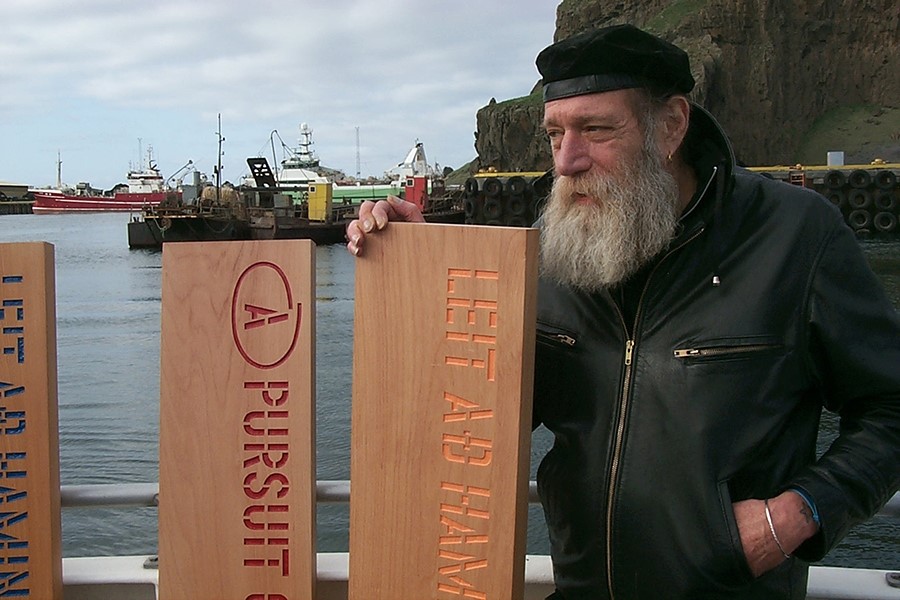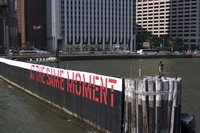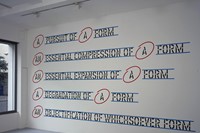Lawrence Weiner, born in the Bronx in 1942, is part of a generation of artists who changed the course of art history with their conceptually driven work. A sculptor who works with language...
Lawrence Weiner, born in the Bronx in 1942, is part of a generation of artists who changed the course of art history with their conceptually driven work. A sculptor who works with language, Weiner's artworks are presented in the form of texts in recognisable, blockish fonts or as sculptures. One might see a realised piece such as TWO MINUTES OF SPRAY PAINT DIRECTLY UPON THE FLOOR FROM A STANDARD AEROSOL SPRAY CAN (1968) or imagine a work such as A CLOTH OF COTTON WRAPPED AROUND A HORSESHOE OF IRON TOSSED ON THE CREST OF A WAVE (2008). AnOther met with him to discuss his latest show, opening today at London's Lisson Gallery.
Though your work is not site specific, it often seems to resonate particularly in the context in which it is placed.
Whatever I’m working on has a relationship between any human being’s relationship to the world as it exists. It all becomes site specific, it all becomes referential. I’ve found that sculpture is a universal medium. We all have to walk across the room, we all have to sit on chairs.
There’s a runway piece I made in France in a parking lot, which uses the words ‘(1) FOR THE MONEY, (2) FOR THE SHOW, (3) TO GET READY and (4) TO GO’. This comes out of the fact that I have had a lot of friends who are, or who have been, runway models. I have a great appreciation for runway models. It’s 5:30 in the morning and they’re there. They’re complaining but they’re there. Why would they do it? It’s exhausting, terrible, psychological work to do and you don’t have any control over yourself. One, for the money, two for the show. They have a real obligation to the designer. If a designer is nice to a model, then for years they will come out for them, even if their career is collapsing. Three to get ready. Deep breath. (It’s like Raging Bull where he pours the ice in the pants.) And four to go. Now, it's in a parking lot in France, where people have to come from outside the area. You drive your car there and you need to get yourself prepared to go out into another world. You’re no longer in this protected metal thing. So it’s the perfect place to have this piece. It just fitted.
"I have a great appreciation for runway models. Why would they do it? It’s exhausting, terrible, psychological work to do and you don’t have any control over yourself. One, for the money, two for the show."
Viewers often imbue your work with very specific meaning that you might not have intended. SMASHED TO PIECES (IN THE STILL OF THE NIGHT) (1991), a large public work in Vienna, was interpreted by many there as referring to the events of Kristallnacht.
That piece had nothing to do with Kristallnacht. It was to do with the fact that listening to smashing bottles in a major city such as Vienna takes on a very different tone in the middle of the night. You make something because you like the green of a Jameson bottle of whisky, you put it out there, and somebody responds because they have this desperate need to understand their relationship to green for whatever reason. Either they were brutalised in Ireland or green was the colour of the eyes of the only person that they ever fell in love with. They can take what you’ve made and use it in their life to understand their place in the real world. All art should be this universal. Artists have a role in this society and it’s a real honest to goodness role. And that’s to take these universal things and place them out there and... be that as it may.
You are less interested in the work of artists that intrinsically contains social or biographical details...
I worked in a candy store when I was young and I worked on the docks. I learned nothing from it. It doesn’t affect the work. It’s not there. Rothko came from an upper class family: it’s not there. De Kooning was an immigrant: it’s not there. It might be there one night in a bar. It might be there one morning when you’re having some domestic argument. But why would I want to know what an artist’s parents did?
You find hierarchy very troubling, particularly in light of young artists who are excluded from studying because of financial pressures.
I look at every art student that I see, and that is the greatest compliment to what I do. I mean, come on! I mean I can be critical, but I think they are making the right choice, because art really is one of the most important things. Do you realise that all of the dreams, all of the political revolutions that were dreamt about in the 50s, 60s and 70s – things relating to the dignity of human beings – they didn’t fucking happen? The shit hit the fan. It’s all over the floor. It doesn’t work, it didn’t happen. The one thing that did motherfucking happen was that the entire structure of what was considered as art changed, worldwide. Radically. It changed the entire culture, of the 20th and of the beginning of the 21st century. Now that is revolution. That is something. That is something that one should be very proud of. And when it’s turned around, and it becomes a game of exclusion, and it’s happening in my profession – I’m angry.
Lawrence Weiner: BE THAT AS IT MAY runs until January 12 2013.
Text by Laura McLean-Ferris






